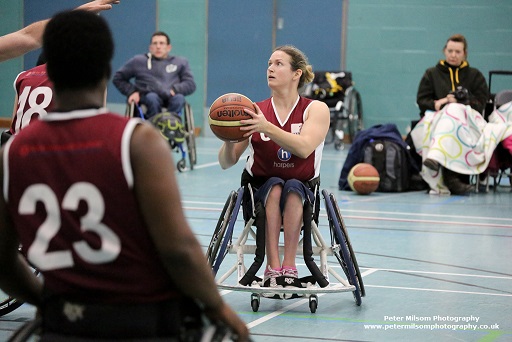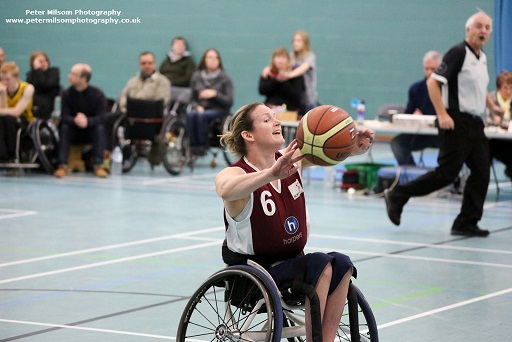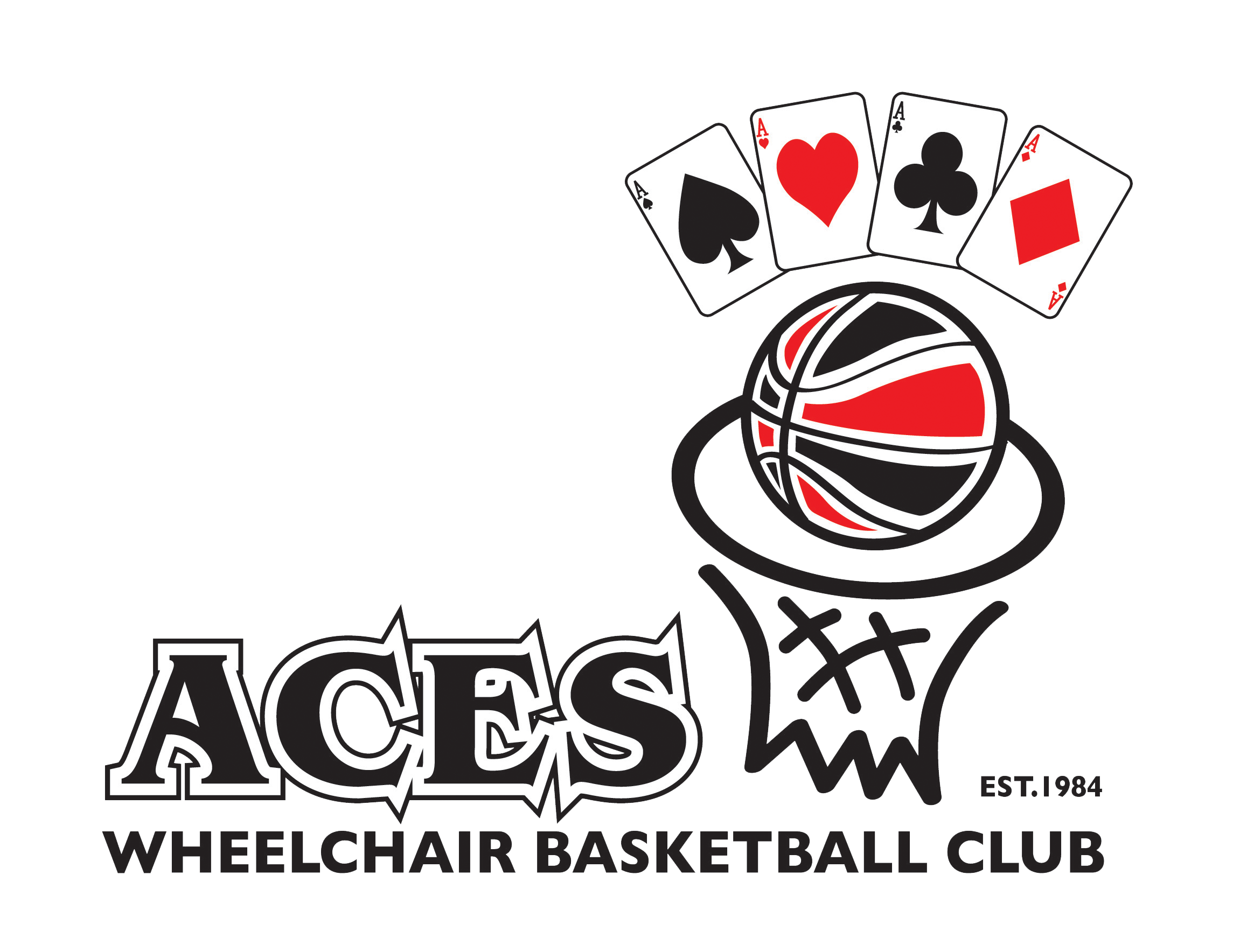About Wheelchair Basketball
Wheelchair Basketball is a fast, exciting sport played by both men and women, with or without a disability.
Wheelchair Basketball is identical to the able-bodied version and is played on the same courts with the same height baskets and most of the same rules as “the running game”.
Wheelchair Basketball is a well established and growing sport in Great Britain, with over 700 players, forty clubs and approximately 60 teams competing in the Superleague and 1st, 2nd, 3rd and 4th divisions of National League.

Simplified Rules of Wheelchair Basketball
The Game
The aim of each team is to score in the opponent’s basket and to prevent the other team from scoring. A match consists of 4 periods of 10 minutes – but that 10 minute clocks stops every time the whistle is blown. There are 2 minute breaks between the 1st and 2nd periods and between the 3rd and 4th periods. The half time break is 10 minutes.
The Team
Each team consists of up to twelve players, but only five may be on the court at any one time. In the Third Division, the total points of all the players on court must not exceed 15 points (see further below under “Classification”). Only one able-bodied player for each team may be on court at any one time. Junior players (i.e. those under 19 in the National League) are deducted 1 point from their classification whilst playing in the National League. Female players are deducted 1.5 points whilst playing in the National League, for example, a female player who is classified as a 3 point player will only “cost” their team 1.5 points whilst playing in the National League.
Tip Off
The match begins with a tip-off. The referee tosses the ball vertically upwards between 2 opponents at the centre circle. The ball must be tipped (not caught) by one or both of the opponents, only after it reaches its highest point. All other players shall remain outside the circle until the ball has been touched. All other quarters are started by the team in accordance with the alternating possession rule (see more below). At the start of the 2nd, 3rd and 4th quarters, the team next due possession in accordance with the alternating procedure, inbounds the ball from the centre line extended, opposite the scorers table.
Scoring
A basket scored from the field counts for 2 points, unless it is shot from beyond the 3-point line, where it counts for 3 points. A free throw counts for one point. After a basket has been scored, the ball is thrown in from the end line by the opposing team within.
Dribbling
Dribbling is when a player moves whilst bouncing the ball. This can be done by placing the ball on the players lap whilst that player takes up to two pushes – they must then bounce the ball before they can push their chair again. A “traveling” foul will be given if a player pushes the chair more than twice without bouncing the ball – the ball will then be given to the opposing team who will throw the ball into play from the sideline or end line.
Time Rules
- When a player is handed the ball by the referee in order to throw the ball in from the side line, that player then has 5 seconds to pass the ball into play.
- A closely guarded player who is holding the ball must either pass, shoot or dribble the ball within 5 seconds.
- An offensive player cannot remain in the key for more than 3 seconds. To reset this 3 seconds all of the player’s wheels (including castors and anti-tip) must be brought outside the key. This 3 second period is also reset if a shot is taken that hits the ring.
- When a defensive player gains control of the ball in their backcourt (i.e. their defensive end) that team must cause the ball to go into that players front court (i.e. over the half way line) within 8 seconds.
- Whenever a player gains control of a live ball on the court that players team must attempt a shot within 24 seconds. If that shot hits the ring (but does not go in) the 24 second clock will reset.
- The penalty for breach of any of these time rules is that the opposition will be given the ball for them to throw it in from the side line.
Throw Ins
When throwing the ball in all of the players wheels (including the front castors) must be behind the line.
Fouls
1. Personal Foul
A personal foul is a foul by a player on an opponent involving contact with his/her person or chair.
In relation to personal fouls (i.e. on the person) if a player reaches outside the “cylinder” which surrounds their chair and makes contact with another player whilst outside their cylinder that player will be responsible for that contact.
There are many different types of personal chair foul but the most common ones are:
Charging – where a player hits another players chair without controlling or making an attempt to control their chair.
Backing – where a player moves their chair backwards and makes contact with opposing players chair.
Holding – where a player uses their chair to interfere with the movement of the opposing players chair (usually by pushing their chair forward into the other players chair).
Footplates – is where a players two rear wheels come up off the floor (which frequently happens when a player collides with another chair).
The Penalty for a personal foul is a throw-in from the sideline or end line by the opposition.
2. Shooting Foul
A personal foul on an opponent or opponent’s chair whilst that opponent was in the act of shooting for basket.
The penalty for a shooting foul is 2 free throws (or 3 if outside the 3 point line) awarded to the player fouled if they did not score as they were shooting; if they scored, 1 free throw allowed.
3. Unsportsmanlike Foul
This is a personal foul committed by a player who deliberately makes contact with an opponent with the purpose of preventing him/her from playing normally and which was not a genuine attempt to play the ball.
The penalty is 2 free throws awarded to the player fouled, unless the player was shooting and scored, whereas only 1 free throw awarded, followed by side-line possession.
4. A Disqualifying Foul
A disqualifying foul is any flagrantly unsportsmanlike behaviour by a player, substitute, coach, assistant coach or team follower. A player or coach will also be disqualified after receiving 2 unsportsmanlike/technical fouls in one game.
5. Technical Foul
Any deliberate or repeated non-cooperation or non-compliance with the rules and the spirit of the rules is considered a technical foul. This includes behavior like waving your hand in the face of another player whilst they are attempting to shoot or knocking the ball away after a basket has been scored. Lifting, i.e. when a player raises up out of the chair to gain an unfair advantage, is also a technical foul. Lifting both rear wheels off the floor is also a technical foul. If the coach were to play 5 players whose points total (see further below under Classification) added up to a total of more than the 15 points permitted in the 3rd division, this would also be a technical foul.
Fifth Foul by Any Player
A player who commits his/her fifth personal foul must leave the game. He/she may be replaced by another player.
Team Fouls
When a team (as a whole) has committed 4 fouls in any one period all subsequent personal fouls by the players of that team will be penalised by the opposing team being awarded 2 free throws.
Free Throws
If a shooting player is fouled in the act of shooting they will be awarded free throws – if they are shooting in the 2 point range and they score the basket, that player will be awarded 1 free throw (i.e. “and 1”) and if they miss their original shot they will be awarded 2 free throws. If the player was shooting from the 3 point area and they score the basket they will be awarded 1 free throw but if they miss their original shot they will be awarded 3 free throws.
The shooter takes up a position behind the free throw line (front wheels may be over the line). He/she must take the shot within 5 seconds of being handed the ball by the referee. Other players (2 attackers, 3 defenders) may take up positions on the key markings around the restricted area. On the first shot (if more than one shot has been awarded) there is no rebound. On the last shot (or only shot where only one free throw has been awarded) the players lined up along the edge of the key will move in and try to get the rebound as soon as the ball has left the shooters hands. No player (apart from the shooter!) may touch the ball until it touches the ring.
Back Court
A player whose team is in control of the ball in the front court (i.e. in the half of the court that contains the basket they are shooting into) may not cause the ball to go into his/her back court (i.e. back into their defensive half). If this occurs a “back court violation” will be called and the ball will be given to the opposing team – for them to throw in from the side line at a point parallel to where (on court) the ball is touched by the player that was on attack.
Held Ball
A held ball situation is where one or more players from each opposing team have one or more hands firmly on the ball so that neither player can gain control without undue roughness.
Alternating Possession
As already described, a jump ball starts only the first period of the game. The team gaining possession from the jump-ball will be deemed to have first possession. The table official has a directional arrow on the table which they will point in direction of play of team not gaining first possession. Each time a held-ball situation occurs the table official will reverse the direction of that arrow. In the event of a held-ball situation the referee, after blowing the whistle, will check the directional arrow on the table and award possession in favour of the team indicated. The team entitled to the next alternating possession at the end of any period shall start the next period with a throw in at the centre line extended opposite the scorer’s table.
Out of Bounds
The ball is out of bounds when:
- it touches the floor or any person or object situated outside the court or on the boundary lines;
- it touches a player who is himself outside the court or on the boundary lines;
- it touches the backboard support or the back of the backboard.
To cause the ball to go out of bounds is a violation and is penalised by awarding the ball to the opponents for a throw-in.
A player is out of bounds when all or any part of their body or chair is outside the edge of the court. If a player goes off court to gain an advantage that player will be warned and then may be given a Technical Foul.
These are very abbreviated rules to give you a flavour of our sport.
This version of the rules should not be relied upon.
A full copy of the IWBF rules can be found at http://www.iwbf.org/ by clicking on “Downloads”.
A copy of the GBWBA league rules can be found at http://www.gbwba.org.uk/ by clicking on “Downloads” and then “League Rules”.

A VERY Brief Guide to Classification
Each player in the league must be classified before they can take part in league matches. As already mentioned above, in the National League 3rd Division the sum total of points for all the players on court at any one time must not add up to more than 15 points.
Wheelchair basketball players are classified on their functional capacity (i.e. their ability to complete the skills necessary to play eg. pushing, shooting, rebounding, dribbling, passing and catching) – with a 5 point player being able bodied and a 1 point player having the most severe functional difficulties. Only one able- bodied player is permitted on court (for each team) at any one time.
Players are assigned points as their classification – 1, 2, 3, and 4 are the recognised classes, with 0.5 classes available for exceptional cases which do not fit exactly into one class, and the 4.5 category for the player with least or minimal disability. As already mentioned able bodied players are 5 point players.
The precise distinctions between the classes are technical and very complicated and more complete guidance can be found on the GBWBA and IWBF websites mentioned above, but the following may be considered a very brief guide:
Class 1 – significant loss of stability in the trunk so that (for example) the player would need to hold onto the chair (or wheel) with one hand whilst making a one handed pass or reaching for a rebound etc. whilst pushing Class 1 players will lean into the back of the wheelchair, with head movement forward and back with each push. Typical Class 1 Disabilities include: T1-T7 paraplegia without abdominal muscle control, post-polio paralysis with arm involvement and without control of trunk musculature.
Class 2 – mild to moderate loss of stability in the lower trunk. This may result in little loss of stability during passing but usually Class 2 players will reach for rebounds with one hand whilst stabilizing by holding onto the chair with the other hand. Class players will be able to push the wheelchair without total support of the back of the wheelchair. Typical Class 2 Disabilities include: T8-L1 paraplegia, post-polio paralysis without control of lower extremity movement.
Class 3 – excellent stability of the trunk in a forwards and backwards direction. Class 3 players suffer little loss of stability during upright passing and can usually rebound forcefully with two hands overhead by moving the trunk forward while reaching for the ball. Limited stability during reaching laterally for rebounding; often executed by holding the side of the wheelchair with the off hand. Able to push the wheelchair forcefully with no loss of anterior or posterior stability. Typical Class 3 Disabilities include: L2-L4 paraplegia, with control of hip flexion and adduction movements, but without control of hip extension or abduction. Post-polio paralysis with minimal control of lower extremity movements. Hip disarticulation or above-knee amputees with very short residual limbs.
Class 4 – able to move the trunk forcefully in the direction of the follow-through after shooting. Class 4 players are able to flex, extend and rotate the trunk maximally while performing both one-handed and two-handed passes and can lean forward and to at least one side to grasp an over-the-head rebound with both hands. Class 4 players are able to push and stop the wheelchair with rapid acceleration and maximal forward movement of the trunk. Typical Class 4 Disabilities include: L5-S1 paraplegia, with control of hip abduction and extension movements on at least one side. Post-polio paralysis with one leg involvement. Hemipelvectomy. Single above- knee amputees with short residual limbs. Most double above-knee amputees. Some double below-knee amputees.
Class 4.5 (minimal disability) – able to move the trunk forcefully in all directions during shooting and passing Class 4.5 players can lean forward or to either side with arms overhead to grasp the ball and are able to push and stop the wheelchair with rapid acceleration and maximal forward movement of the trunk. Typical Class 4.5 Disabilities include: Single below-knee amputees. Some double below-knee amputees. Players with extensive orthopedic involvement of hips, knees or ankles. Post-polio paralysis with minimal (ankle/foot) involvement on one or both sides.
The above text is from the site of CELTS Wheelchair Basketball and are used with their consent.

